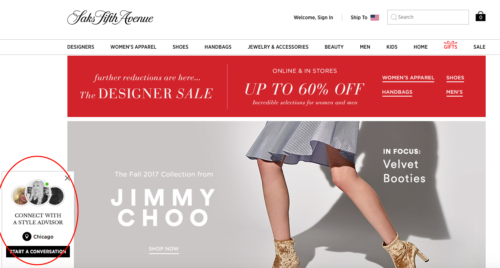IRCE Key Takeaways Part 1
This blog is the first in a series of key takeaways from the 2017 Internet Retailer Conference and Exposition (IRCE).
Earlier this month, I had the opportunity to attend the annual Internet Retailer Conference and Exhibition (IRCE). IRCE is one of my favorite events of the year — partially because the event is held right in PowerReviews’ hometown of Chicago — and partially because I’m always impressed with the great content and networking opportunities it provides for ecommerce pros.
Barbara Corcoran from Shark Tank kicked things off on the first day of the event. Barbara has a really interesting success story, borrowing $1,000 to start a real estate company when she was 23 years old, which she went on to grow into a $5 billion business. Based on her own success — as well as the experiences of businesses she’s invested in over the years — Barbara shared insights with the audience on how to take risks and be more successful. She also challenged folks to see mistakes and setbacks as opportunities to forge new paths to success. It was a really energizing way to kick off IRCE 2017.
Subsequent breakout sessions focused on a wide range of topics — from digital marketing and customer service — to omnichannel strategies and how to be successful on online marketplaces.
While attending sessions on Wednesday and Thursday, I noticed a few key themes emerge.
- The value of brick and mortar retail and the importance of creating a truly omnichannel experience
- How mobile is changing the way consumers shop
- The role of video in the customer journey
In this blog, I’ll focus on the first theme — creating an omnichannel experience for your shoppers. Future posts will focus on the other themes.
Providing a Seamless Experience Across Channels
I attended a session presented by Tony Fross, Vice President of Digital Strategy for Capgemini Consulting. Tony shared the results of a survey Capgemini conducted, which identified consumers’ frustrations with in-store shopping. The survey found that 32% of consumers would rather wash dishes or do laundry than go shopping in stores.
This is probably a discouraging stat for brands and retailers with physical store locations. But it doesn’t have to be. Tony went on to discuss how customer frustrations with the in-store experience are inherently linked to the conveniences of online retail. This is a big opportunity for retailers to bring key aspects of the online shopping experience, in-store.
Using Online to Enhance In-Store, and Vice Versa
It seems like everyday, we’re bombarded with headlines about another retailer closing stores. But contrary to what many may think, there is still tremendous value in brick and mortar retail. In fact, according to Gregg Throgmartin, President and General Manager for Fabletics, “It’s one of the best times to open a brick and mortar store.” Fabletics — previously an online-only retailer, recently opened 18 retail stores in 13 months and has experienced tremendous success both online and in-store. In fact, Fabletics has found that customers who shop both channels are happier — with 32% higher NPS scores, 231% higher lifetime value, and 121% more purchases (and post IRCE, we have the Amazon acquisition of Whole Foods, in case you need further proof of the importance of the value of the in-store experience).
The secret is to successfully leverage digital and physical store assets to enhance each other — something Fabletics does well. For starters, the brand has built a fitting room experience that does a great job providing in-store shoppers with assets and information they’d typically only get online. For example, fitting rooms feature localized user-generated content. So if you’re in the fitting room of a Fabletics store in Chicago, you’ll see user-generated content that was submitted from other consumers in Chicago. This content can provide inspiration and ideas to in-store shoppers — which can lead to larger transactions.
In addition, personalized digital signage in fitting rooms allows for cross-channel purchases. If you try on a few items in-store but decide not to buy, these items will be saved in your cart so you can easily purchase online later without having to search for specific products and remember which sizes worked for you.
Fabletics also leverages in-store feedback to improve products and the customer experience across all channels. For example, in a store, associates can get feedback from shoppers about why they chose not to purchase a particular product. This can help inform online product descriptions or even changes to the product itself. Gregg mentioned that the in-store conversion rate of a particular pair of leggings was 81%. However, they found that the conversion rate for the XS size was only 74% and the conversion for the XXS size was 51%. Thanks to in-store feedback, they identified a size-grading issue with the XS and XXS leggings regarding fit in the calf area. As a result, the design team worked with production to address the fit issue and improve the conversion rate for these smaller sizes.
People-Powering Your Website
There’s a ton of chatter about omnichannel retail. But the truth is, in most cases, consumers aren’t getting a seamless shopping experience across in-store and online channels. For example, if a shopper is in a department store receiving help from a sales associate, that connection is lost as soon as the consumer leaves the store.
Saks Fifth Avenue is changing that. I attended a session led by Joe Milano, Senior Vice President, General Manager, Digital Retail for Saks Fifth Avenue and Oscar Sachs, CEO of Salesfloor. During the session, Joe discussed how Saks was generating a lot of traffic to its website, but its sales associates were best at making connections with shoppers and closing a deal. Saks saw an opportunity to “people power” its website, allowing customers to shop online directly with their favorite local Saks Style Advisor. Each Style Advisor can create their own personalized version of the Saks’ website with personalized product recommendations and live shopping experiences.
Shoppers who don’t have a preferred Style Advisor can connect with a local associate via live chat or a texting platform directly from the retailer’s website. By doing so, they can receive the personalized, 1:1 assistance they’d receive in a Saks store.

Brick and mortar is very much alive and well, and many consumers are still opting to shop in a physical store. The brands and retailers that will be survive — and thrive — are those that successfully connect the online and in-store experiences.
What was your favorite session from IRCE 2017? Please share in the comments below!





